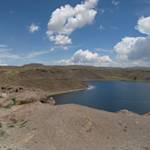China's Severe Dust Storms "Yellow Dragon"
1994 - 2000 • China
“Between 1994 and 2000, desert lands in China grew by nearly 53,000 square kilometers (20,300 square miles) - an area more than the combined area of New Hampshire and Vermont. In the country's driest regions, such as Inner Mongolia, drifting sands smother grasslands in scenes reminiscent of the Dust Bowl days of the 1930s in the U.S. Midwest. China...has 20% of the world's population but only 7% of the world's arable land. China's current desertification…affects the lives of 400 million people…severe sandstorms, known as yellow dragons, frequently turn Beijing's sky yellow, blind its residents by cutting visibility to less than 90 meters, and dump as much as 30,000 tons of sand on the city. Yellow Dragon sandstorms sometimes merge with rain clouds to inundate the city with mud. In the last decade, Beijing has been subjected to increasingly frequent and more severe dust storms.”
Pipkin, Bernard, Dee Trent, Richard Hazlett, and Paul Bierman. Geology and the Environment. S.l.: Cengage Learning, 2014. Print.
Courtesy of Shizhao


Learn about Maya Lin’s fifth and final memorial: a multi-platform science based artwork that presents an ecological history of our world - past, present, and future.

Discover ecological histories and stories of former abundance, loss, and recovery on the map of memory.

Learn how we can reduce our emissions and protect and restore species and habitats – around the world.

See how art can help us rethink the problems we face, and give us hope that each one of us can make a difference.

Help make a global memorial something personal and close to home. Share your stories of the natural world.


